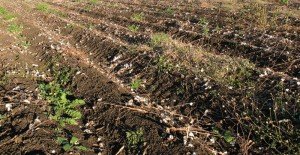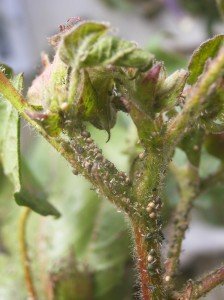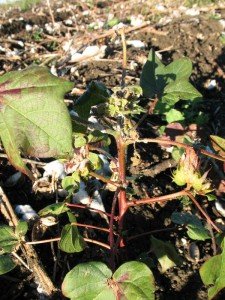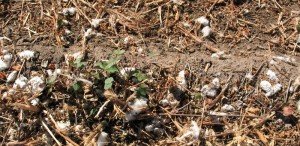
Start low – It’s a numbers game
If you have pest populations in weeds and dirty fallows in spring, you run the risk of early infestation of crops, and potentially larger crop losses.
Research has shown that the risk of population outbreaks in SLW is primarily driven by two factors; the size of the initial population in spring and the summer temperatures. Higher starting numbers give the whitefly the edge over their natural enemies and reduce the number of generation it takes to reach outbreak levels.

What risks do the pests pose?
Cotton aphid
There are high aphid populations on volunteer cotton in some cotton growing areas. In last season’s disease survey, bunchy top was commonly observed on volunteer cotton plants surviving over from the previous season. The earlier CBT is transmitted to cotton, the greater the potential yield loss. Combined with industry concerns about aphid resistance to neonictinoids, the removal of overwintering hosts where aphids are present should be seen as a priority.
See the earlier blog for another discussion of the importance of crop hygiene in minimising the risk of bunchy top.
Mealybug
In addition to Burdekin and Central Highlands Solenopsis Mealybug have now been confirmed in cotton growing areas of Dawson, Balonne, and Darling Downs.

Weedy field perimeters and poor channel hygiene was also associated with mealybug infestations.
Will mealybug be a problem next season?
In June and July, entomologists from DEEDI conducted repeat surveys of five fields, in the Emerald region. These fields had a history of severe mealybug infestation last season. Mealybug were still present in both surveys despite crop destruction after harvest. Mealybug were found on volunteer and ratoon cotton. Fields with a high incidence of volunteers consistently had higher mealybug numbers. Other problem weeds noted as stand outs – in terms of being abundant across fields and having a relatively high frequency of mealybug incidence include pigweed, bladder ketmia and bellvine. Mealybug were found on the plants and also as far as 5cm below the surface – perhaps overwintering here.
Establishing a host free period for mealybug, to minimise carryover, is going to be a challenge this season. Research by DEEDI entomologists has demonstrated that mealybugs can survive up to 60 days without food, and during that period can continue to produce offspring.
There are a lot of things we don’t know about mealybug or the potential for another outbreak next season. However, the clear association between in-crop weediness and volunteers and mealybug hotspots makes it clear that farm hygiene should contribute to minimizing the likelihood of a high starting population.
Managing ratoons and volunteers
Managing volunteers/ratoon cotton is always challenging. In field, cultivation and herbicides can be effective in controlling volunteer cotton, however the following points should be considered:
- The effectiveness of registered herbicides is generally limited to volunteers no more than 4-6 leaf. The size of the volunteers needs to be assessed before a herbicide selection is made.
- Larger plants will be more difficult to control in a single pass.
- Using the recommended water volumes for application is imperative for effective control.
- Other weeds within the field should be taken into consideration when making a herbicide selection.
- It is important to read all labels to confirm the correct application timings and rates. Label directions must be followed.
Control of volunteers growing outside fields (along channels, roads and fences) is even more challenging as herbicide control is not always possible.
Manual chipping is sometimes the only effective option, particularly where volunteers are well established. While this is an intensive strategy, it is a good investment when taking into account the potential costs and losses caused by pests such as SLW, aphids and now mealybugs.
Article by Susan Maas, Melina Miles and Kate Charleston

